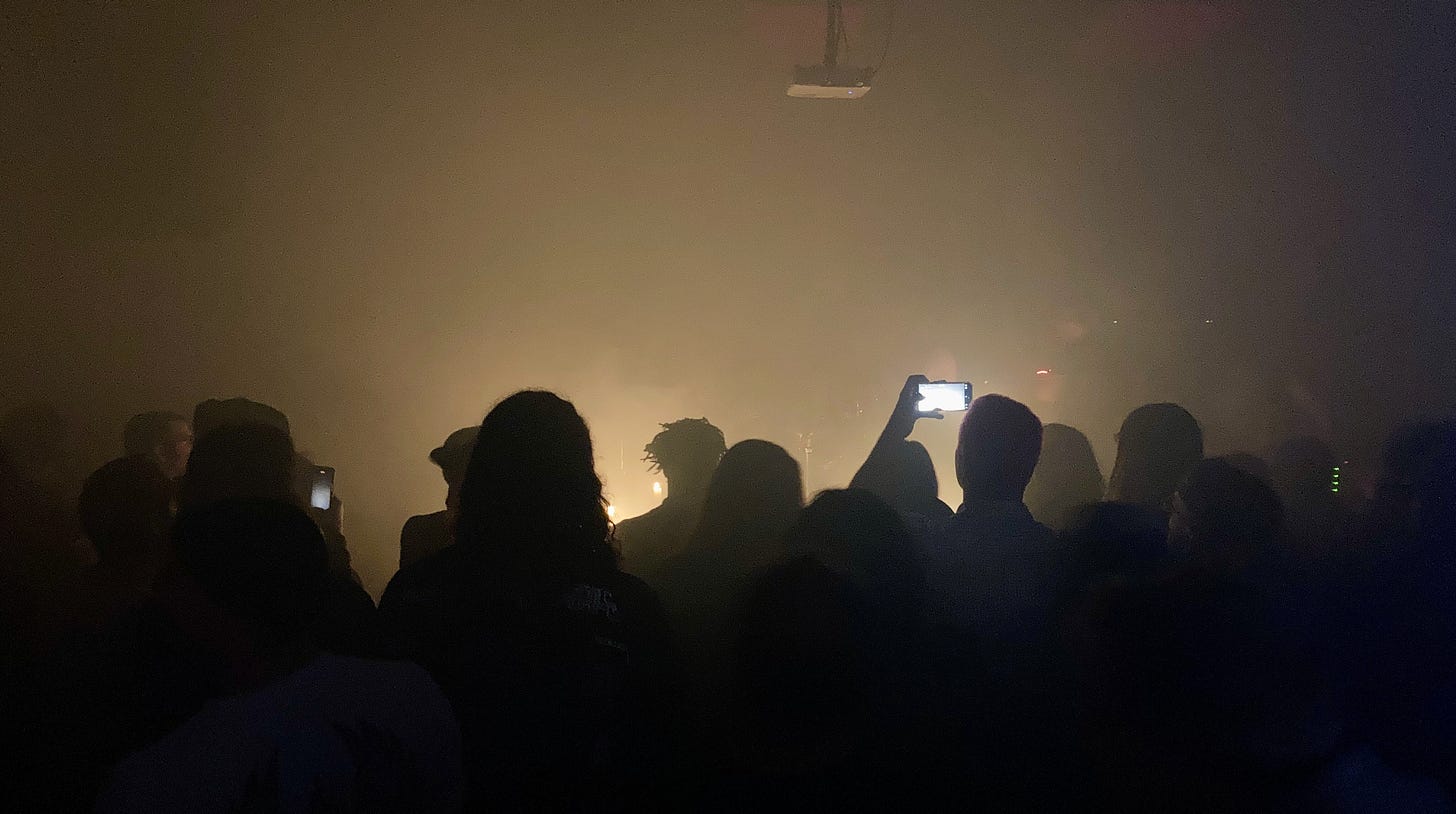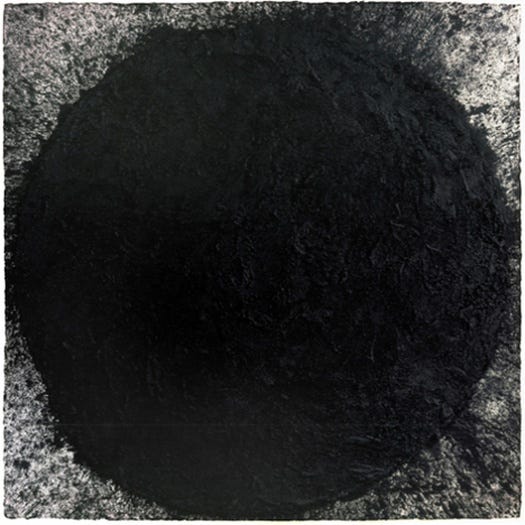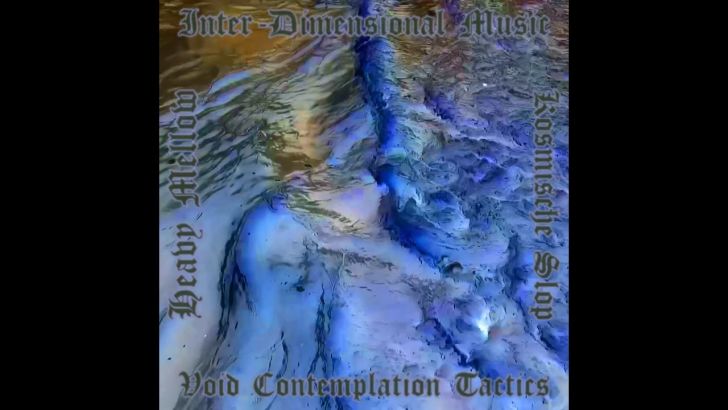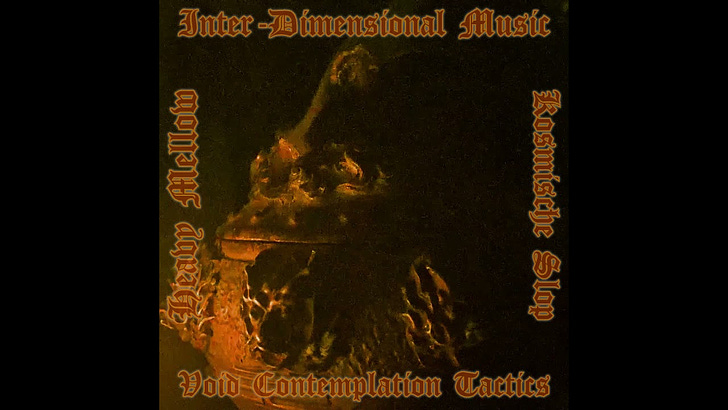Why Dost Thou Hide Thyself in Clouds?
Dark adaptations of corporeal reality made with fog juice, kosmische death metal, and James Turrell
The death metal that hits the way I like best is death metal expressed as organic, geologic, or atmospheric abstraction. Black metal is the extreme music that most often venerates nature: As most heads eventually realize, kvlt music about snow is way heavier than kvlt music about Satan. Traditional doom metal is often where to look when seeking the pastoral “Beauty in Falling Leaves” or mournful odes to The June Frost. But death metal is the sound that feels like a proto-lingual expression of the full cycle of natural processes and phenomena. From life to death and the profound and macabre psychedelia of its aftermath; the mess we leave behind. It’s the saprophytic yin to ambient music’s restorative yang, unsettling field recordings of the fermentation and rot percolating beneath the scummy surface of the reeking bog where Irv Teibel documented classic soother “Dawn In The Okefenokee Swamp.”
In the case of Spectral Voice’s performance at Black Circle in Indianapolis Tuesday night, it was the sound of something gurgling and croaking in a state of prolonged guttural asphyxiation. Like the wheezing mutant swamp hog of Jeff VanderMeer’s Southern Reach trilogy, the sound of the entity’s malignant respiration was inescapable, yet its form was lost in waves of candlelight-flecked fog. A few people still tried to capture the moment with telephone cameras, but when the murk showed no signs of clearing, most of us closed our eyes or banged our heads or rocked slowly back and forth, buffeted by the humid atmosphere and wet, ragged sonic vibrations.
Afterward we convened on the rainy porch of the Indianapolis brewery and music/drag show/karaoke/craft fair venue to check basketball scores and commiserate over the Pacers’ brutal second-round playoff loss to the Knicks. Once we had processed our grief and vowed to avenge Myles Turner, it was time to debrief.
“I’ve never seen anything like that,” said a friend with whom I have seen many metal shows. It was a statement to be taken literally: Other than fleeting glimpses of the bass player – whose instrument occasionally glinted in the light of the 30-40 candles spread across the stage – we didn’t see anything resembling the other three large dudes in the band. At least not until their final riffs faded into the house DJ’s set of choral-heavy horror movie soundtracks, and four shadowy forms skulked off the stage like so many raccoons.
I’ve seen Sunn O))) – the esteemed drone metal artists – a half dozen times over the last 20 years, in venues from small clubs to monolithic cathedrals. They rarely spare the fog juice, but their robed forms usually remain visible, whether as stationary monochrome silhouettes in the Black One days, or technicolor druids emerging from the rainbow haze of Life Metal-era stage configurations. Spectral Voice could’ve cued up a SBD recording from earlier in the tour and headed on a burrito run for all I could tell. Also, it was one of the most immersive sensory music performances that I’ve experienced.
With the cover of 2009’s Monoliths and Dimensions, Sunn found profound visual accompaniment in Richard Serra’s Out-of-round X (1999), their darkly restorative full-body-massage drones rendered as tactile chasm in paintstick-on-paper. Spectral Voice’s disembodied performance reminded me of James Turrell’s Pleiades (1983), an “experience” installed at The Mattress Factory in Pittsburgh. Visitors encounter the work on a completely darkened floor of the museum: There is only darkness at first, as the viewer feels their way along the wall to a viewing platform. As photoreceptor protein molecules gradually regenerate in the viewer’s eyeballs, a hallucinatory projected light slowly becomes visible on the far wall.
“Pleiades is a Dark Piece where the realm of night vision touches the realm of eyes-closed vision,” Turrell writes in an artist statement, “where the space generated is substantially different than the physical confines and is not dependent upon it, where the seeing that comes from ‘out there’ merges with the seeing that comes from ‘in here,’ where the seeing develops over and through dark adaptation but continues beyond it.”
Like Spectral Voice’s performance, it is something intrinsically resistant to camera phone documentation, in part because the light from a digital camera neutralizes the experience. If you think the projection is the artwork, then you’ve missed the point. The artwork only exists in the intangible space between observer and observed, and in the ways that the act of observation changes both of them. Pleiades is represented only as Turrell’s installation blueprint in the Mattress Factory’s online catalogue.
“Who was singing?” another friend – who spent the show directly in front of Black Circle’s modest stage – asked. “Was anyone singing? I couldn’t see any of them.”
I responded by saying pretentious things about ego death, the state of being alone together and melting into an anonymous morass, and “sounds from beyond the provisional realm of names and forms.”
“You could say the vocals were almost . . . spectral,” someone else replied, suggesting it was time to break up the party and head home.
To clear things up for the uninitiated, while my heady rhetoric about death metal as a direct experience of the natural world might suggest something more sublime than Corpsegrinder, Crematory Stench, or Cattle Decapitation, it’s still brutal stuff. If you don’t like death metal, it will probably just sound like more death metal. As with meditation, yoga, James Turrell installations, and more base psychoactive practices, the experience is determined by the unique set the observer brings to the setting.
Spectral Voice’s flawless 2024 album Sparagamos is inspired by “the Dionysian rite of being torn limb from limb, set[ting] the stage for a profound exploration of life, death, and the untamed essence within.” My film studies syllabus in college included many attempts at Marxist and feminist critiques (and appreciations!) of blood-spattered grindhouse fare, but I’ve never been into gore for gore’s sake. In a similar way, I was more squeamish about looking at the images of traumatic injuries in first responder training than I was about laying my gloved hands on traumatically injured patients in the back of the ambulance. Sparagmos’ lyrics are indiscernible. It’s not about dismemberment1; it is the ecstatic crunch of something wet as it decays and breaks apart, as expressed by guitars, bass, drums, lungs, and larynxes.
Hope Against Hope
Learning the difference between hoping and helping as a black market medic in Far West Texas
To get even more granular, Spectral Voice is usually filed under “death-doom,” a hybrid strain that gums up death metal’s speedy intricacy with doom metal’s ponderous resin. More straightforward death metal like Morbid Angel, Possessed, or Blood Incantation – a band that shares two members with Spectral Voice – sounds like humans playing their instruments at face-melting tempos, coordinating their movements at terrifyingly high velocity, like a flock of starlings, meteor shower, or peloton descending from the Alps. Metal bloggers might have a blast coming up with gory hyperbole to describe their favorite riffs, but most death metal sounds less like a goblin vomiting into a tree-chipper, and more like horror movie nerds riffing and drumming really, really fast: deedly-deedly-deedly is the technical term.
Death-doom comes closer to delivering on geologic, botanical, or biological metaphors, with tectonic double-kick-drum rhythms that sound like boulders crashing down a mountainside, basslines that creep like kudzu, and guitars that grumble and screech like a mischief of rats getting hungry under the floorboards. There are vocal performances that sound like enraged humans, and others that sound like depressed monsters having a meltdown. In Spectral Voice’s case, the vocals are capital W weird: simultaneously ethereal and grimy, supernatural yet unmistakably corporeal. If you can’t see the person singing from within the radiant cloud of candlelit fog, their voice reverberates and melts into the atmosphere to the point where it’s easy to forget that the sound is coming from a human. When the sound is separated from the instrument making it, guitars morph into chiming bells or bellowing horns, basslines become keyboard drones, kick drums are shuddering thunderclaps. For what it’s worth, it’s the drummer – Eli Wendler, who you may recognize from fellow Colorado death metal supergroup Black Curse – rasping and croaking on the mic.
While I was thrilled to experience Spectral Voice’s transcendent death-doom opus in the flesh, the opening bands were also a revelation. Indianapolis has been the home to two of my top-five-dead-or-alive music venues – Black Circle, and the long-gone Fifth Quarter, a grungy bar located in the basement of a derelict high school – but it’s been awhile since a local band has satisfied my annoyingly specific and gratingly pretentious criteria for metal. I will always be heartbroken that I returned to Indiana from two decades in California and Texas shortly after the demise of Coffinworm, a terrifying Indianapolis-based death-doom-sludge hybrid with surprisingly swinging songs like “Spitting Into Infinity’s Asshole.” Their music becomes much more uncomfortable when you understand that the band looks to the body horror poetics of PJ Harvey for inspiration, along with the usual occult touchstones.
Rows of Endless Waves II: Funereal Doom
Considering funereal metal and other hesher dirges as durational awareness practice
Fort Wayne’s Observer.2 brought some variety to this weeknight bill, the young band’s fully-formed death metal/hardcore sound a good indication that something interesting is happening in the northeastern Indiana city that most people probably know as “The Magnet Wire Capital of The World,” or from the provocatively titled short story collection Fort Wayne is Seventh on Hitler’s List3.
Or if you follow underground metal scandals, you will also surely remember the city making blog headlines in 2015 when the former singer of Fort Wayne’s Nuclear Hellfrost defaced the grave of Dimebag Darrell, the legendary guitarist for unreconstructed Confederate jock-jam-band Pantera. He later apologized after receiving credible death threats from every living Pantera fan. Vøid Contemplation Tactics does not endorse cemetery crime nor the self-proclaimed “not a homophobe” defiler’s use of the f-slur in his act of defacement. But we share the opinion that Pantera sucks and feel that lead singer Phil Anselmo’s tendency to get wasted and start throwing Nazi salutes does invite the charge that, to quote the defiler, “panturrrra [is] a buncha racist h*llb*llies.” As a native Hoosier, I feel that self-proclaimed non-homophobes using homophobic slurs to attack the legacy of popular shit heads for being racist is extremely on brand for Indiana. Maybe next time save us all some trouble and plant a rainbow flag on his grave. None of this has much to do with Fort Wayne in 2024 as far as I can tell.
Fort Wayne’s Observer. makes death metal that relays a philosophical lyrical approach to deep space terror with the terrestrial floor-punching hardcore delivery that makes me hurt my back if I’m listening at the gym. The lead singer appeared to be wearing Dollar Store Ray-Bans under a tweed newsboy hat, from which a magnificent rat tail emerged and sneaked down the back of his sleeveless shirt. He wrapped the mic cord around his neck and hyped around the stage while the guitar players head-banged gracefully, and the hypnotic rhythm section roused pumping fists – if not a circle-pit – from the crowd. They seemed at home on the bill between Atavistic Decay’s cosmic death metal and Spectral Voice’s unearthly hymns to dismemberment, joining crossover thrash bands like Power Trip (RIP), Judiciary, and Primal Rite in carrying the hardcore/metal torch passed down from Autopsy and DRI.
When I talked to the band at their merch table earlier in the evening, it wasn’t surprising that they included a list of all-ages clubs and house venues as one of the reasons that Fort Wayne bands were suddenly on my radar. Their city is also on my timeline4 because it keeps making the list of the most affordable cities in the US: the less time you spend worrying about making rent, the more time you have to make commercially unviable art.
Atavistic Decay, the first band on last Tuesday’s bill, is more excellent otherworldly death-doom in the style of Spectral Voice and their fellow travelers. Album art that features an amorphously organic shape with lots of tiny lines is a good sign that you’re about to experience something eldritch and existential, relayed with sick and spindly riffage. Their performance is more difficult to write about because they presented as faces and voices and instruments, rather than as billows of vaporized water and glycol-based fluids.
“Why Dost Thou Hide Thyself in Clouds?” Sunn asks on their 2008 live album Dømkirke, quoting William Blake’s “To Nobodaddy.” It wouldn’t be surprising if the mystical heshers in Spectral Voice were as averse to inquiries about their atmospheric production design as they are to vamping on stage. But paraphrasing Turrell’s Pleiades statement offers an appropriately cryptical answer: So that the seeing that comes from “out there” merges with the seeing that comes from “in here.”
Thank you all once again and forevermore for subscribing for free, subscribing for money, lurking anonymously, sharing this with your nice friends, hiding it from your mean friends, or smashing that unsubscribe button if these dispatches from “out there” no longer merge with whatever you’ve got going on “in here.”
c u in the pit,
D “Cosmic Chambo” C
P.S. Here’s two good death metal-leaning Inter-Dimensional Music mixes from awhile back. No Spectral Voice, but lots of stuff from that zone if you’re looking for jumping off points:
Cosmic Chambo presents Rituales de lo Habitual
stream
artist - track
Kwan Um School of Zen - Kwan Seum Bosal Chanting
timber rattle - he'eile moloa'a
Neurosis/Tribes of Neurot - Belief
Crash Worship - Awake
Phurpa - 02.3
Grave Upheaval - II-VI
DEAFKIDS - Teste de Ansiedade
Phrenelith - Ornamented Dead Eyes
Gabrielle Roth & The Mirrors - Night Whisper
Dagar Brothers - Raga Kedar
timber rattle - she not well
Kwan Um School of Zen - Kwan Seum Bosal Chanting
Inter-Dimensional Music 20211008
It is with a spirit of lovingkindness that I welcome you to this hour of heavy death affirmations ranging from canonical monographs to radical contemporary treatises on impermanence. Listen for Mortiferum, Ripped to Shreds, Altarage, Incantation, Ominous Circle, Tzompantli, Cavurn, Immolation, Void Rot, and Vastum.
If you know anyone who might find value or otherwise enjoy Vøid Contemplation Tactics or Inter-Dimensional Music, please pass it along. It means a lot to me! Thank you.
Word of mouth is my primary form of promotion. My reach is limited on social media, which is a good thing as far as my own mental health goes. As Dōgen's teacher told him, “You don't have to collect many people like clouds. Having many fake practitioners is inferior to having a few genuine practitioners. Choose a small number of true persons of the way and become friends with them.”
If you’d like to support these projects with a one-time donation, you can also drop some ducats in the tip jar.
Death metal people like to say “what if dismemberment is good, actually” even more than Bataille. See also Cryptopsy’s “Orgiastic Disembowelment,” Blooming Carrion’s “Crystallized Disembowelment,” Act of Impalement’s “Disembowelment Rituals of Moloch,” or Australia’s diSEMBOWELMENT, a band that is compared to the Cocteau Twins more often than you might expect.
The period after their name is where the comparisons to moe. begin and end, for better or worse depending on your enthusiasm for a jam band/death metal hybrid.
The Highly Weird artists Mark Rogers and Erica Peebus have become a popular case study in people moving from expensive cities like Portland, Oregon, to cheaper Midwestern locales like Fort Wayne. As seen in this condescending Wall Street Journal feature (accessed on the r/FortWayne subreddit) which politely assures readers that Portland’s rise in crime is due to drug law reform and public criticism of police violence, a situation that could be improved if the mayor would do more to criminalize homelessness.















I love Spectral Voice and am actually offended by myself for not having seen them yet. Also, I see you tucking Crash Worship into that playlist. I feel like I could draw a line from those Crash Worship performances to Spectral Voice as you describe via Turrell.